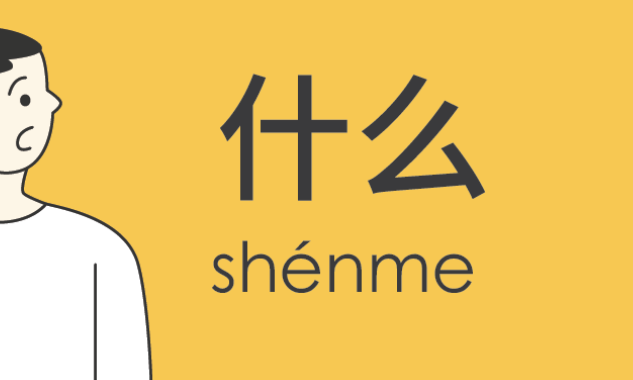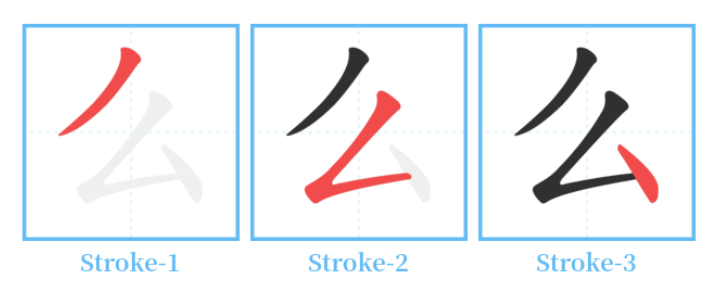How to Say “What” in Chinese? Definition, Pronunciation, And Usage
When learning Chinese, “what” is probably one of the first and most important words you will know. Saying “what” in Mandarin is one of the most common and important phrases for Chinese beginners. It translates to “什么” (shén me) in Mandarin. If you don’t know how to use “what” in Chinese, even the simplest conversations can be difficult.
In this comprehensive guide, we’ll explain everything you need to know about how to say “what” in Mandarin, from definitions and pronunciation to pinyin, examples, and more. If you want to learn more about the basics of Chinese, then check it out together!
“What” in Mandarin Chinese
The most common meaning of “what” in Chinese is “什么”. The Chinese word “what” consists of two characters. The first character, “什” (shén), is a separate word for “what” or “why” meaning. Its different meanings depend on the word next to it and on different Chinese contexts. The second character is “么” (me), and the meaning of this character generally depends on the other Chinese characters used with it.
Learn authentic Chinese from those who live and breathe the culture.
Specially tailored for kids aged 3-18 around the world!
Get started free!You can also use “什么” to build simple sentences or phrases. For example, “没什么” (méi shénme) means “it doesn’t matter”.
In English sentences, “what” is placed before demonstrative pronouns (this, that, these, those) or subject pronouns (I, we, he, she, they), such as “What is this?” However, in the Chinese language, the word “什么” is often placed after demonstrative or subject Pronouns like “这是什么?” (zhè shì shénme?) translates to “This is what?”

The Basics of Saying “What” in Chinese Language
The most common word for “what” in Mandarin is “什么” (shénme). It is pronounced more like ‘shummuh’ (shénme) with a falling pitch. Here’s a quick start guide on saying “什么” (shénme):
- Pronunciation: “shénme” with a falling tone on the second syllable. Say it quickly, almost as one syllable.
- Characters: 什么 – The first character means “what”.
- Usage: Place “shénme” at the end of the sentence to ask “What is…” questions. For example:
这是什么? (Zhè shì shénme) – What is this?你在做什么? (nǐ zài zuò shénme) – What are you doing?你想要什么?(nǐ xiǎng yào shénme) – What do you want?
- Responses: Answers will start with the object in question. For example:
这是笔。(Zhè shì bǐ) – This is a pen.我在吃饭。(wǒ zài chī fàn) – I am eating.我想要那本书。(wǒ xiǎng yào nà běn shū) – I want that book.
So the basic formula is: Ask a question with “shénme” at the end and get an answer stating the subject first.
“What” in Chinese With Different Pronouns
Here are some general sentence examples using “什么” (shén me).
什么 As Interrogative Pronoun
The word “what” becomes a subject-form interrogative pronoun when no demonstrative or personal pronoun is used in the sentence.
Examples of how to use “什么” as a subject-form interrogative pronoun:
- 什么意思?(shén me yì si) – What is the meaning?
- 什么问题?(shén me wèn tí) – What is the problem?
- 发生了什么事情?(fā shēng le shén me shì qing) – What happened?
什么 With Demonstrative Pronoun
Chinese Demonstrative Pronouns such as 这, 那, 这些, 那些 (zhè, nà, zhè xiē, nà xiē) are placed at the beginning of the sentence when you are using English Demonstrative Pronouns and when there is no Personal Pronoun used.
Examples:
- 这是什么?(zhè shì shén me) – What is this?
- 那是什么?(nà shì shén me) – What is that?
- 这些是什么?(zhè xiē shì shén me) – What are these?
- 那些是什么?(nà xiē shì shén me) – What are those?
什么 With Subject Pronoun
If you make a sentence containing a subject pronoun, the Chinese word “什么” becomes an object question pronoun. The subject pronoun is placed at the beginning of the sentence. If you want to make a sentence in the past tense, the word “了” (le) is added after the verb.
Examples:
- 你喜欢吃什么?(nǐ xǐ huān chī shén me) – What do you like to eat?
- 你说什么?(nǐ shuō shén me) – What are you saying?
- 你做了什么?(nǐ zuò le shén me) – What did you do? (past tense)
什么 With Object Pronoun
When you use an object pronoun (I, we, she, he) in a sentence, the Chinese word “什么”’ becomes a subject interrogative pronoun. It is written in the form (what + noun) and placed first in the sentence.
Examples:
- 什么事情让我生气? (shén me shìqíng ràng wǒ shēngqì) – What are the things that make me angry?
- 什么会让我们留下来? (shén me huì ràng wǒmen liú xià lái) – What will make us stay?
什么 With Both Subject and Object Pronouns
In Chinese, subject and object pronouns use the same word – 我 wǒ,你 nǐ,他 tā,她 tā,我们 wǒ men,你们 nǐ men.
In English, personal pronouns can either be I or Me. While in Chinese, the personal pronouns are the same character (我 vs 我) or wǒ, this can confuse when they appear at the same time in the sentence.
Examples:
- 我不知道你刚才说什么? 我听不清楚. (wǒ bù zhī dào nǐ gāng cái shuō shén me? Wǒ tīng bù qīng chǔ.) – What are you talking about just now? I can’t hear clearly.
- 你能提供什么帮助? 我需要它. (nǐ néng tígōng shén me bāngzhù? Wǒ xūyào tā.) – What help can you offer? I need it.
Different Meanings of “What” in Chinese
In addition to the basic translation of “什么”, “what” also has some other common meanings in Chinese.
“What” in Chinese – 怎么 zěn me
Besides 什么 (shén me), another way to express “what” in Chinese is “怎么” (zěn me). 怎么 (zěn me) has limited usage, for it is often translated to “how” in Mandarin Chinese language instead of “what.” Using 怎么 (zěn me) or 什么 (shén me) will depend on the version you want to express in English.
For example, the sentence “What happened?” in Chinese is 怎么了 (zěn me le). You mainly want to know how it happened and not what happened.
“What” in Chinese – 啊 á
In Chinese, “啊” (á) can also be used to mean “what” in some cases. However, it is usually used in very specific contexts.
When “what” is translated as 啊 in Chinese, it can be used to express surprise or skepticism, or when a person doesn’t quite hear what the other person is saying and asks the other person to repeat it.
For example, if someone is speaking quickly or unclearly, you can respond with “What?” – 啊? á
Another example is when someone mentions something unexpected in a conversation. Suppose someone tells you amazing news, you might exclaim, “啊 真的吗?” (á zhēn de ma?). Here, “啊” is used to express your surprise as part of an overall response, similar to saying “What, really?” in English.

What in Chinese – 啥 shá
In Chinese, “啥” (shá) is a common colloquial word for “what”. It is a more informal way of asking, especially in Chinese dialects.
The usage of “啥” is simple. For example, when you want to ask “What are you doing?” – “你在干什么?” (nǐ zài gàn shén me), you can say “你在干啥?” (nǐ zài gàn shá). This usage is often used in daily conversations to make the communication sound more friendly and approachable.
Note: “什么” is more formal and can be used in written language; “啥” is more colloquial and is generally less used in formal language, especially in documents, academic papers, or official announcements.
Frequently Asked Questions
1. How to say “what” in traditional Chinese?
In traditional Chinese, “what” can be translated as “甚麼” (shén me) or “什麼” (shén me). In some literary or ancient Chinese contexts, “何” (hé) can also mean “what”.
For example:
“你在做甚麼?” or “你在做什麼?” (What are you doing?)
2. How to write “what” in Chinese characters?
Step 1: Deconstructing the glyphs
什 (shén):
Structure: left-right structure (the left side is ‘亻’, the right side is ‘十’).
Stroke order: 1. Skim (丿) 2. Vertical (丨) 3. Horizontal (一) 4. Vertical (丨); (4 strokes in total)
么 (me):
Stroke order: 1. Skim (丿) 2. Skim-fold (𠃌) 3. Dot (丶); (3 strokes in total)
Step 2: Writing Demonstration
“什”: write the left ‘亻’: the apostrophe is short and the vertical is long, and the vertical starts from the middle of the apostrophe. Then write the ‘十’ on the right: the horizontal is flat and vertical, and the horizontal is slightly longer than the vertical.

“么”: Write the short apostrophe first, then the apostrophe fold (folding out from the middle of the apostrophe to the lower right), and finally the dot. Note: the last stroke is a dot, not a press!

Conclusion
Correctly using “what” in Chinese has many benefits for your Chinese learning, as it is used frequently in many conversations. You may find it difficult and confusing at first, but with continued learning, you will find it very simple.
If you found this article helpful and you want to learn Mandarin more deeply, you can learn more about Mandarin through the WuKong Chinese course.
Learn authentic Chinese from those who live and breathe the culture.
Specially tailored for kids aged 3-18 around the world!
Get started free!
Master’s degree from Yangzhou University. Possessing 10 years of experience in K-12 Chinese language teaching and research, with over 10 published papers in teh field of language and literature. Currently responsible for teh research and production of “WuKong Chinese” major courses, particularly focusing on teh course’s interest, expansiveness, and its impact on students’ thinking development. She also dedicated to helping children acquire a stronger foundation in Chinese language learning, including Chinese characters, phonetics (pinyin), vocabulary, idioms, classic stories, and Chinese culture. Our Chinese language courses for academic advancement aim to provide children with a wealth of noledge and a deeper understanding of Chinese language skills.




![A Comprehensive Guide to Basic Chinese Grammar [ with Rules and Sentence Structure] A Comprehensive Guide to Basic Chinese Grammar [ with Rules and Sentence Structure]](https://wp-more.wukongedu.net/blog/wp-content/uploads/2025/03/image-349-520x293.png)















![50 Best Mother's Day Quotes; Wishes; Messages [2025] 50 Best Mother's Day Quotes; Wishes; Messages [2025]](https://wp-more.wukongedu.net/blog/wp-content/uploads/2024/04/image-6-520x293.jpeg)


![How to Start Learning Chinese for Beginners [2025 Guide] How to Start Learning Chinese for Beginners [2025 Guide]](https://wp-more.wukongedu.net/blog/wp-content/uploads/2024/02/image-421-520x293.png)


![5 Best Courses for Online Chinese Classes [2025 Updated] 5 Best Courses for Online Chinese Classes [2025 Updated]](https://wp-more.wukongedu.net/blog/wp-content/uploads/2023/12/online-school-6956161_1280-520x293.jpg)

Comments0
Comments